
Overview
April 10 - May 31, 2025
Opening Reception: April 10, 5:30-8pm
Featuring Jack Capellini, Cassidy Clark, Lila Condie, Chris Feighery, Raya Gauntlett, Eva Hernández, Jeremiah Kim, George Leonard, Valerie McLaughlin, and Abby Williams. Light & Shadow showcases the culmination of a year-long senior capstone course, where these eight students reflect on their journey through diverse artistic disciplines. Over their time at SJU, they have explored their passions across art history, graphic design, photography, ceramics, painting, and more. Through hands-on studio work and critical thought, they have been challenged to express themselves in new media and respond to artistic concepts, merging creativity with industry-informed practice.
Jack Capellini
My series of illustrations is meant to empower neurodivergent individuals by telling the story of a neurodivergent character through a three-dimensional lens. The protagonist of my project is Archer, a cynical, neurodivergent armadillo ostracized by his community. He befriends Plepp, another neurodivergent armadillo with a positive outlook—their friendship blooms, providing Archer with comfort and acceptance. However, when Plepp disappears, Archer falls back into self-loathing and sets out on a dangerous journey to find her. He discovers an entire community of neurodivergent armadillos, including Plepp, who left to seek a sense of belonging. Inspired by this new family, Archer gains the confidence to challenge the oppressive system they grew up under and returns to uplift other neurodivergent members still struggling.
Using ink pens, sketching paper, and digital pastel colors, I wanted to create a tangible and grounded series of illustrations. I find myself drawn to the art styles of illustrators like Quinton Blake and William Steig for their identifiability and subtly in storytelling. Being identifiable and subtle was something that I kept at the back of my mind as I drew down Archer’s journey into a vast and complex world. Each panel’s thin linework and simple texture convey two universal themes that I think nearly every neurodivergent individual can relate to; self-love and self-reliance.
The message I wanted to convey in this series is the importance of being vigilant when you are being mistreated. Rather than allowing yourself to be subjected to discrimination, you should advocate for yourself and others who are being oppressed in an unfair system. It is important to remember that you are not alone and that others experience ostracism. However, it is also vital for your well-being that you do not become dependent on others to advocate for you. Things are never going to change unless self-love and self-reliance come first. Rather than allowing a friendship to become a crux of your life, you should see it as a positive addition to your life. As an autistic student, I often struggle to advocate for myself as I derive comfort and security from relying on the opinions of other people. I often find myself afraid to speak up when hardship comes my way. I don’t think this is something that I only struggle with, as I suspect that many autistic individuals are taught to remain silent and not “rock the boat” whenever they need help. Although I have come to understand that the important people in my life do have my best interest at heart, I still often feel uneasy at the prospect of asking for help.
"Archer is Born"
ink drawing / digital hybrid, 20 x 16"
"Determination"
ink drawing / digital hybrid, 20 x 16"
"Time to Reshape Things"
ink drawing / digital hybrid
20 x 16"
Cassidy Clark
Expressing emotions has always felt like trying to breathe through a tightened throat. Decisions that seem simple to others—like choosing a pair of socks or spending a few dollars—become battles with an invisible force, an anxiety that chokes me until I take the path of least resistance. Not because it’s easy, but because anything else feels suffocating. In the past two years, I’ve faced decisions that demanded more than avoidance; they’ve pulled me through fire, forcing an evolution—a "Secondary Succession" of self. This project is a photographic chronicle of choices that broke me and choices that helped me grow, moments suspended in images that capture a painful yet vivid memory.
Looking back, I see a pattern: every time I began to feel okay with myself, I’d catch the faces of others—expressions that told me I was too much. I was too much as a child, too much as a teenager, too much as a college freshman. Society, with its invisible rules, teaches us to shrink, to present only pieces that are palatable. Even now, when “acceptance” is a supposed trend, people still fear rejection if they can’t make themselves small enough. Through this work, I want others to see that their own struggles, their own pain, are real and shared, that we’re not too much for daring to exist fully. We’re not meant to be digested, trimmed, or softened for anyone’s comfort. This is my way of saying: embrace every piece of yourself.
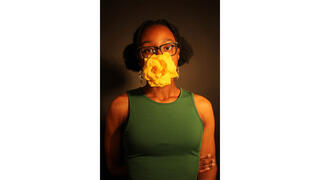
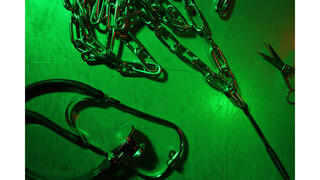
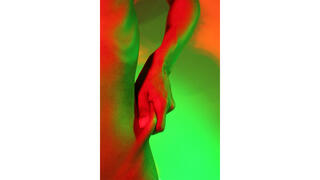
"Good w/the Bad" pigment print
"Going Under" pigment print
"Have You Seen Me" pigment print
Lila Condie
"Kitchen Chronicles" is a cookbook I designed to celebrate my mom’s recipes. This project is deeply personal, motivated by several meaningful reasons. First, my mom has a passion for cooking and collecting cookbooks and often dreams of seeing her recipes in a professionally designed book. Second, I’ve always loved her cooking and wanted to showcase her talent while preserving these cherished recipes. Lastly, my mom envisions this book as a gift for me when I move out, allowing me to recreate my favorite meals and stay connected to home.
This project provided the perfect opportunity to combine my skills in layout design, digital illustration, and studio photography—areas I am deeply passionate about. My goal was to create a cookbook that is vibrant, engaging, and approachable. To achieve this, I carefully selected typefaces and a color palette that reflected this vision, ensuring the design would draw readers in and make the recipes feel accessible and fun.
In my other design work, I often use tall and condensed typefaces. For this project, I wanted to step out of my comfort zone and choose a typeface that felt playful. I selected Chorine, a typeface that combines bubbly and retro elements. Initially, I chose it simply because I liked it, but as the project evolved, I realized it was the perfect choice. Chorine’s nostalgic yet modern feel aligns with the cookbook’s theme, which spans recipes from decades past to just a few years ago. It captures the timeless quality I aimed to convey. For the color palette, I wanted bright, inviting hues that complimented my food illustrations. I curated a cohesive set of five colors that enhanced the book’s vibrant aesthetic.
With "Kitchen Chronicles," I hope to honor my mom’s culinary artistry and inspire others to enjoy these recipes as much as I do.
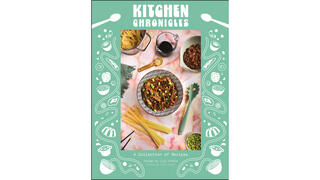
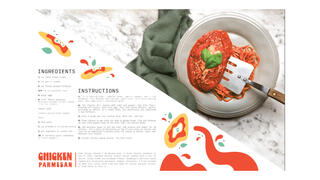

Chris Feighery
The concept of the “stages of grief” has never sat right with me. I think it’s absurd, to be honest. The idea is that death can be accepted, and once that is achieved, the griever can move on with their life. I think that’s ridiculous. In September 2023, my Uncle Rob was diagnosed with brain cancer. Two tumors on his brain stem. Inoperable. Virtually untreatable. He was 61 years old and had just run his third Philly Marathon a year prior. For eleven months, my family and I watched him deteriorate into a husk of his former self. He lost his ability to walk, talk, use his left arm, hear from his right ear, and eat solid food. He lost his ability to live the life he was accustomed to. We knew what was coming but couldn’t believe it was happening. He passed on September 11, 2024. He was 62 years old. The exact age his mother, my Mom Mom, was when she died of Lung Cancer in 2001.
Along with them, you see before you compositions for my great-grandfather, who died in 1965 at 51 years old, and his son, my grandfather, who died in 2011 at 74 years old. With this series, I aim to create a tribute piece for these family members whose deaths still affect my family today. Through these pieces, I combine family photos with editing techniques to visually display the causes of their deaths, the effects of their passing on the family, their remembrance throughout time, and other significant pieces of their lives that still take their toll on us today.
The concept of "stages of grief" has always felt disconnected from my experience. The notion suggests that acceptance brings closure, and to me, that means the subject over which you were grieving no longer holds a prominent place in your thoughts. It’s as if grief is something one simply moves past. I disagree with that. Grief is more complex and enduring. It doesn’t follow a linear path or reach a final stage; it weaves itself into life, resurfacing in predictable and unexpected ways.
In this series, I explore how losses in my family have reshaped our lives, creating absences that linger and memories that remain vivid, regardless of time. Each piece combines personal artifacts and visual effects to evoke how we honor and remember those who are gone. These artworks are a tribute not only to the people who have passed but also to the lasting presence of their lives and legacies. Featured in this series are four of my family members, beginning with my great-grandfather, Robert James Feighery (1913-1965), who passed of liver cirrhosis and pneumonia at 51 years old. Following him is my grandmother (or Mom Mom), Carol Eisfelder Feighery (1939-2001), who passed of Lung Cancer at 62 years old; my grandfather (Pop Pop), Robert James Feighery II (1936-2011), passed of Heart Failure at 74 years old. Finally, closing out the series is a tribute to this series’ inspiration: my godfather, my uncle, Robert James Feighery III (1962-2024), who passed away from a brain tumor in September at 62 years old. Each passing family member has affected my family differently, from how they lived and treated those around them to the circumstances that advanced them to whatever may be waiting beyond this Earthly plane. By reflecting on how we remember them as a family, whether three generations removed or under six months, I aim to capture the universal experience of grief—a process that unfolds in its own time, marked by moments of sorrow, gratitude, and reverence.

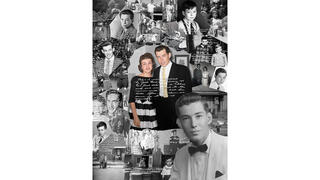
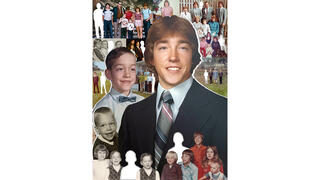
Robert James Feighery
Pigment print
Robert James Feighery, Jr.
Pigment print
Robert James Feighery III
Pigment print
Raya Gauntlett
A home is not defined by walls or structures but by the people who fill it with meaning. Throughout my journey—whether in the place where I grew up or in unfamiliar destinations—it is the people around me who have shaped my sense of belonging and rootedness. Each individual I’ve encountered has left an indelible mark, much like a gardener nurturing life in a once-barren space.
Through my portraits, I seek to capture the essence of those who have impacted me, reflecting their unique qualities and the ways they’ve helped me grow. Each image is a bloom in the garden of my life, symbolizing how relationships transform spaces into homes. By manipulating natural elements in my work, I weave together visual metaphors for these individuals—their strength, warmth, resilience, and tenderness—showing how they have cultivated beauty and meaning in my life.
This work is both a tribute and an exploration of how human connection, like a garden, requires care and intention to flourish. Each portrait tells a story of growth, rooted in the love, challenges, and shared experiences that make up my journey. Together, these moments create a blooming garden that I carry with me wherever I go.



Home Away From Home, Water color and laser cut on pigment print, 14" x 21"
Emily, Water color and laser cut on pigment print, 14" x 21"
Abby, Water color and laser cut on pigment print, 14" x 21"
Eva Hernandez
My series of work seeks to capture the spirit and resilience of Puerto Rico, illuminating the challenges and deep cultural pride that bind us as a people. For too long, government neglect and broken promises have shaped our reality—through power failures, water shortages, and a deteriorating infrastructure that limits opportunities. My work addresses these systemic issues, not merely as a critique, but as a voice for the enduring hardships Puerto Ricans face daily.
Using symbols as simple as a worn school desk, I reflect the erosion of an educational system that should empower our youth but instead leaves them unprepared, their potential neglected. This reality has driven many Puerto Ricans to leave their beloved island, as I once did, seeking opportunities that we hope might someday lead us home. My paintings channel both the sorrow of that departure and a deep yearning to return, rooted in the pride of our shared history and culture.
Through vibrant imagery, sounds, and even flavors, my art invites audiences into the soul of Puerto Rican life. I want them to feel the rhythms of our music, the warmth of our food, and the deep familial bonds that define our community. For my fellow Boricuas, I hope these works evoke the comfort of a grandparent’s home—a place where we are seen, understood, and celebrated. We are the descendants of the cane fields, of the Taínos, of the jíbaro. Through this series, I honor our ancestors and bring attention to the struggles we continue to face, highlighting the resilience that lies at the heart of our identity. My art is a tribute to our heritage, our spirit, and the dream of a better future.
Mi serie capturar el espíritu y la resiliencia de Puerto Rico, dando luz a los desafíos y el orgullo cultural que nos unen como personas. Por demasiado tiempo, el descuido del gobierno y promesas rotas han formado nuestra realidad—a través de apagones, cortes de agua, y una infraestructura en deterioro que limita oportunidades. Mi trabajo aborda estas problemáticas sistémicas, no solo como una crítica, sino como una voz para las dificultades persistentes que los puertorriqueños enfrentan a diario.
Utilizando símbolos tan simples como un pupitre desgastado, refleja la erosión de un sistema educativo que debería empoderar a nuestra juventud, pero que en cambio los deja sin preparación, con su potencial descuidado. Esta realidad ha llevado a muchos puertorriqueños a abandonar su querida isla, como hice yo una vez, en busca de oportunidades que esperamos algún día nos lleven de regreso a casa. Mis pinturas canalizan tanto la tristeza de esa partida como un profundo anhelo de regresar, enraizado en el orgullo de nuestra historia y cultura compartidas.
A través de una imaginería vibrante, sonidos e incluso sabores, mi arte invita a las audiencias al alma de la vida puertorriqueña. Quiero que sientan los ritmos de nuestra música, el calor de nuestra comida y los profundos lazos familiares que definen nuestra comunidad. Para mis queridos Boricuas, espero que estas obras evoquen la comodidad de la casa de un abuelo, un lugar donde somos vistos, entendidos y celebrados. Somos hijos del cañaberal, de los Taínos, del jíbaro. A través de esta serie, honro a nuestros ancestros y destaco las luchas que seguimos enfrentando, resaltando la resiliencia que reside en el corazón de nuestra identidad. Mi arte es un homenaje a nuestro legado, nuestro espíritu y el sueño de un futuro mejor.

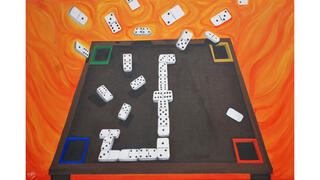
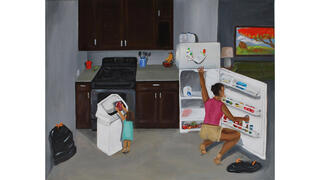
The Grass Isn't Greener on the Other Side, acrylic on canvas, 4' x 5'
El juego (The Game), acrylic on canvas, 2' x 3'
Dale gracias a LUMA, acrylic on canvas and wood, 16" x 20"
Jeremiah Kim
In this series “Midnight Zone”, I explore the mysterious beauty of deep-sea creatures through watercolor and drawing, aiming to capture their semi-realistic yet stylized forms. I was drawn to these extraordinary beings for their alien-like appearances and their profound roles within Earth's ecosystems. While many speculate about extraterrestrial life, I believe we often overlook the remarkable, almost otherworldly life that thrives in our own oceans. Through these depictions, I hope to bring awareness to the unique marine species that inhabit the deep sea, fostering a greater appreciation for the diverse and fragile ecosystems within our planet’s waters.
The choice to work in both drawing and watercolor felt natural to me. Drawing allows me to carefully study the intricate designs of these creatures, while watercolor brings a sense of fluidity and depth, evoking the mysterious, weightless world they inhabit. This project has not only challenged me to refine my techniques but has also deepened my respect for these delicate environments. The ocean’s depths hold creatures and ecosystems that are still largely unknown, and, unfortunately, they are increasingly threatened by human impact. I hope these works inspire viewers to recognize the beauty and importance of marine life, encouraging a sense of stewardship for our planet and its underwater wonders.


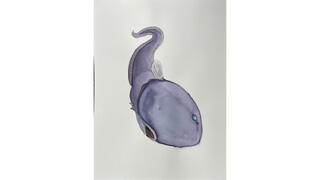
Chambered Nautilus, watercolor on paper, 16" x 12"
Magnapinna Squid, watercolor on paper, 16" x 12"
Tadpole Whiptail, watercolor on paper, 16" x 12"
George Leonard
In this series “Titled”, I explore the layered and evolving identity of Philadelphia through a Photo collage. Using multiple photographs of Philadelphia’s iconic and hidden architecture, I aim to reconstruct the cityscape not as a single, static image but as a dynamic mosaic. Each collage piece embodies a different perspective and angle, capturing the city’s energy and vibrancy, while challenging viewers to reimagine these familiar structures.
My process, which involves photographing each building from various angles, then piecing the fragments together to form a whole that feels alive, fluid, and multi-dimensional. This method aligns with my belief that no building or location is experienced in a singular way. It also mirrors the city’s historical and cultural layering, each one shaped by different eras, people, and purposes. Philadelphia, with its mix of colonial architecture, industrial sites, and modern buildings, embodies this juxtaposition, making it the perfect subject for this visual experiment.
The final images are complex yet cohesive compositions where straight lines rarely meet, and details reveal themselves slowly, encouraging viewers to pause and explore the work layer by layer. I hope that by reassembling these fragments, viewers will see Philadelphia’s architecture in a new way—not as solitary structures, but as parts of a living, breathing cityscape that reflects our collective experience of time, change, and place.



Pink House, pigment print collage, 14" x 36"
Manayunk Church, pigment print collage, 32" x 27"
Touch Museum, pigment print collage, 19" x 58"
Valerie McLaughlin
Valerie McLaughlin is an acrylic painter exploring surrealism and dreamscaping. Raised in Harleysville, Pennsylvania, her work often references her childhood spent outdoors and escaping to storybooks. Through imaginative play the natural world was romanticized to the farthest extent. Her work typically combines landscape with hints of the fantastical, attending to the behavior of light.
Valerie has dabbled in most physical media- such as crochet, sculpture, drawing, and sewing- but has narrowed in on acrylic painting over the past 5 years. After completing her AP Studio art portfolio in 2020 where she expressed the intersection of surrealistic landscapes and mental health issues, she began studying psychology and art at Saint Joseph’s University. Throughout her undergraduate career, and concluded in her senior project thesis, Valerie has continued to navigate these two fields as they relate to one another. She paints a representation of cognitive or emotional conditions as they exist in one’s environment, evoking feelings of nostalgia, peace, anxiety, and escapism. All in all, her work is a display of the idealized imagination daring to exist in the external world.
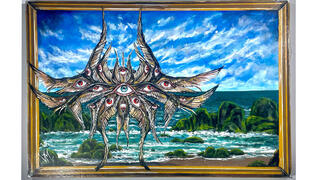
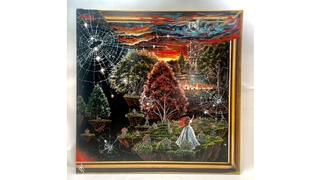
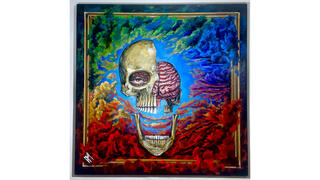
Abby Williams
Since I was a young girl, I have been passionate about storytelling, particularly in the realms of art and theater. A few years ago, I had the thrilling opportunity to portray Ophelia in Hamlet. As I began my character research, I faced the challenge of understanding Ophelia as an individual, distinct from the men surrounding her. I went to great lengths to delve into her struggles and explore her agency. As I immersed myself in Shakespeare's world, I began to notice a similar pattern with women in other stories.
This experience inspired me to combine my two passions of art and theater for a unique storytelling opportunity. My work consists of a series of acrylic portraits on canvas, each spotlighting a different female character from Shakespeare's tragedies. These paintings possess a dark, moody, and narrative quality, drawing inspiration from Pre-Raphaelite works. I aim to capture pivotal moments that reflect each woman's individual story—moments that are often misunderstood or overlooked in favor of more dominant male narratives. Through this work, I hope to foster deeper conversations about these women and invite viewers to appreciate the complexities of their characters and autonomy.
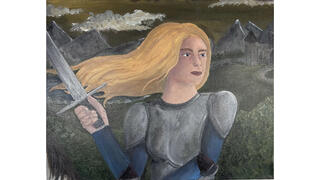


Cordelia, acrylic on canvas
Ophelia, acrylic on canvas
Lady Macbeth, acrylic on canvas